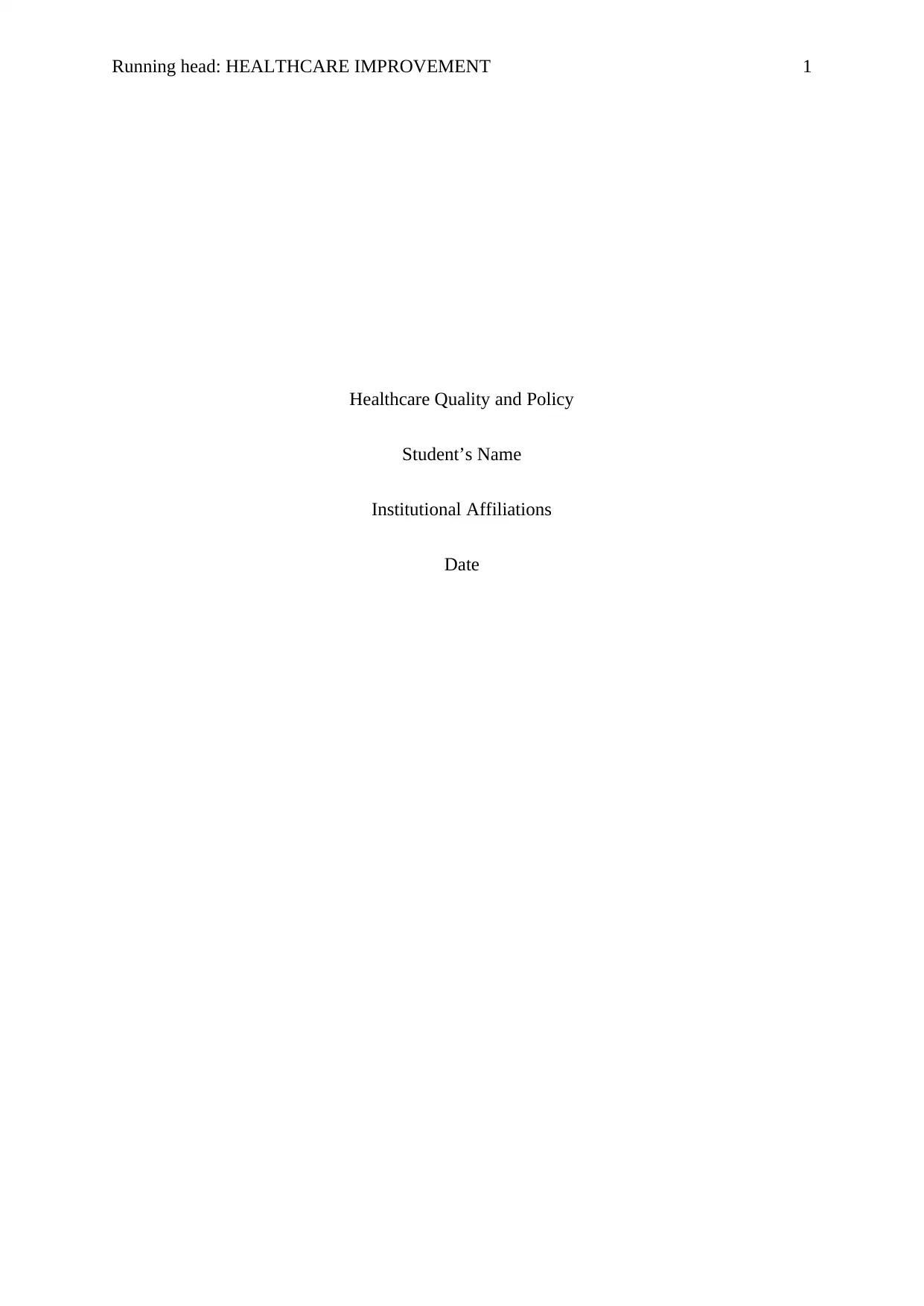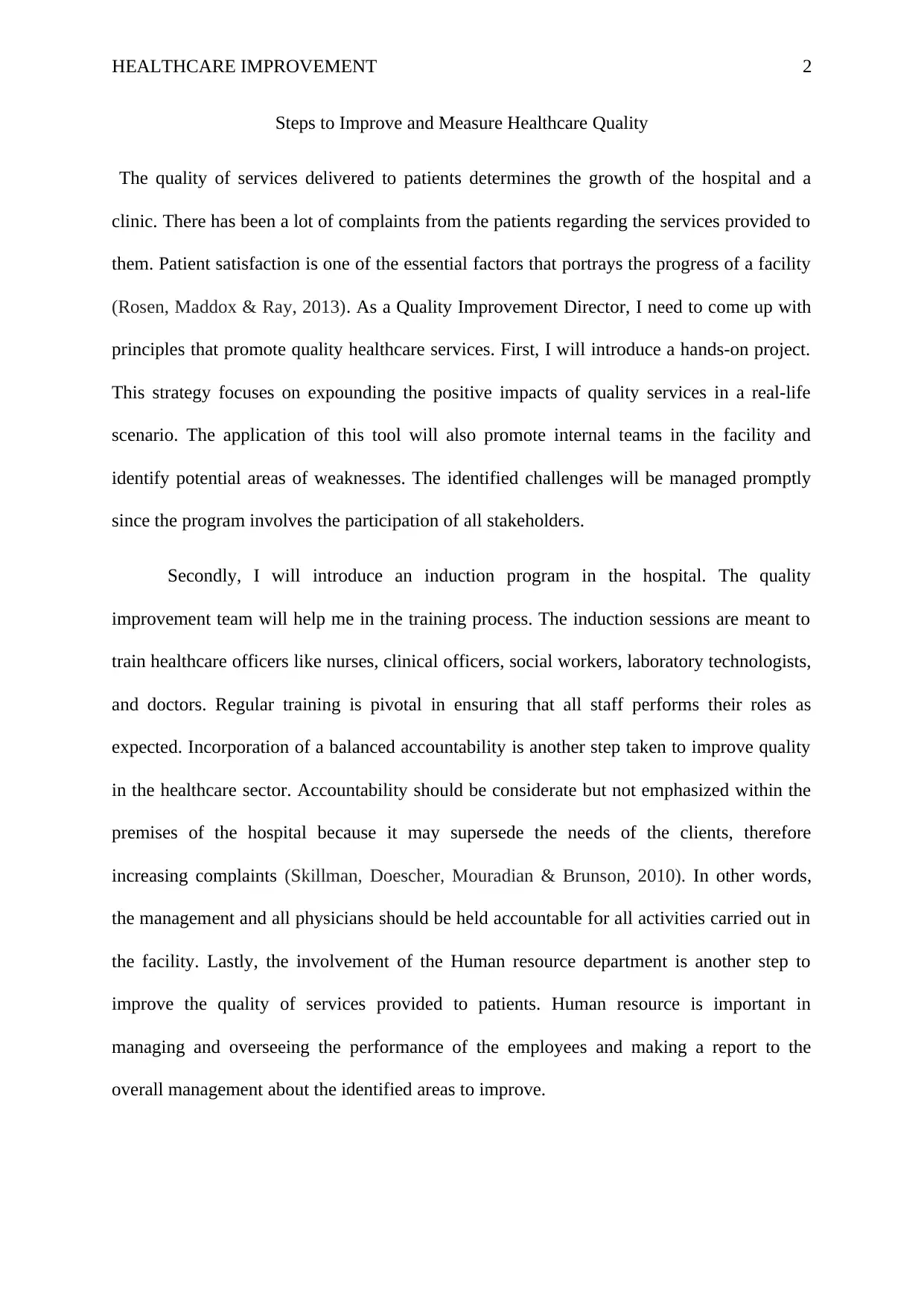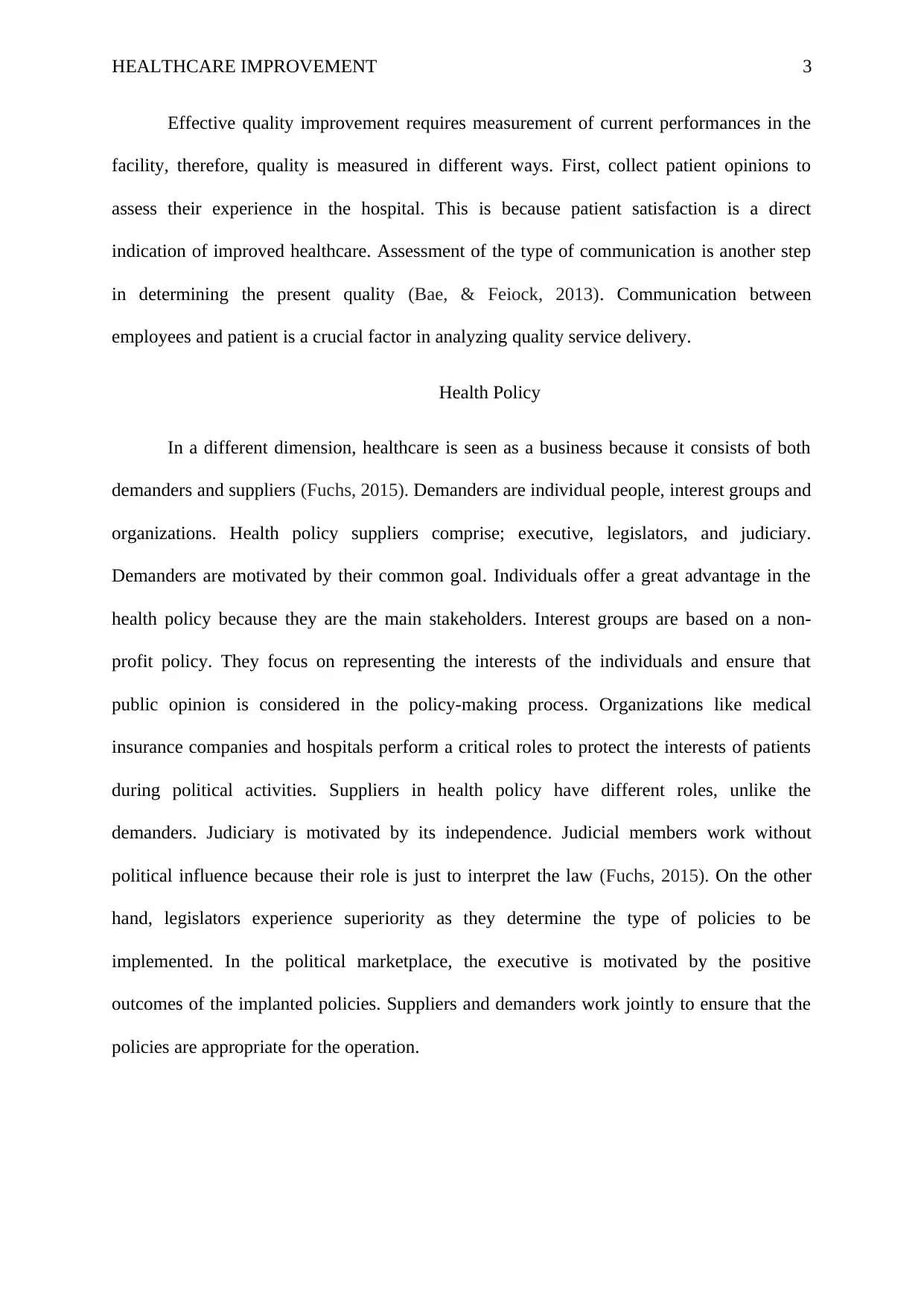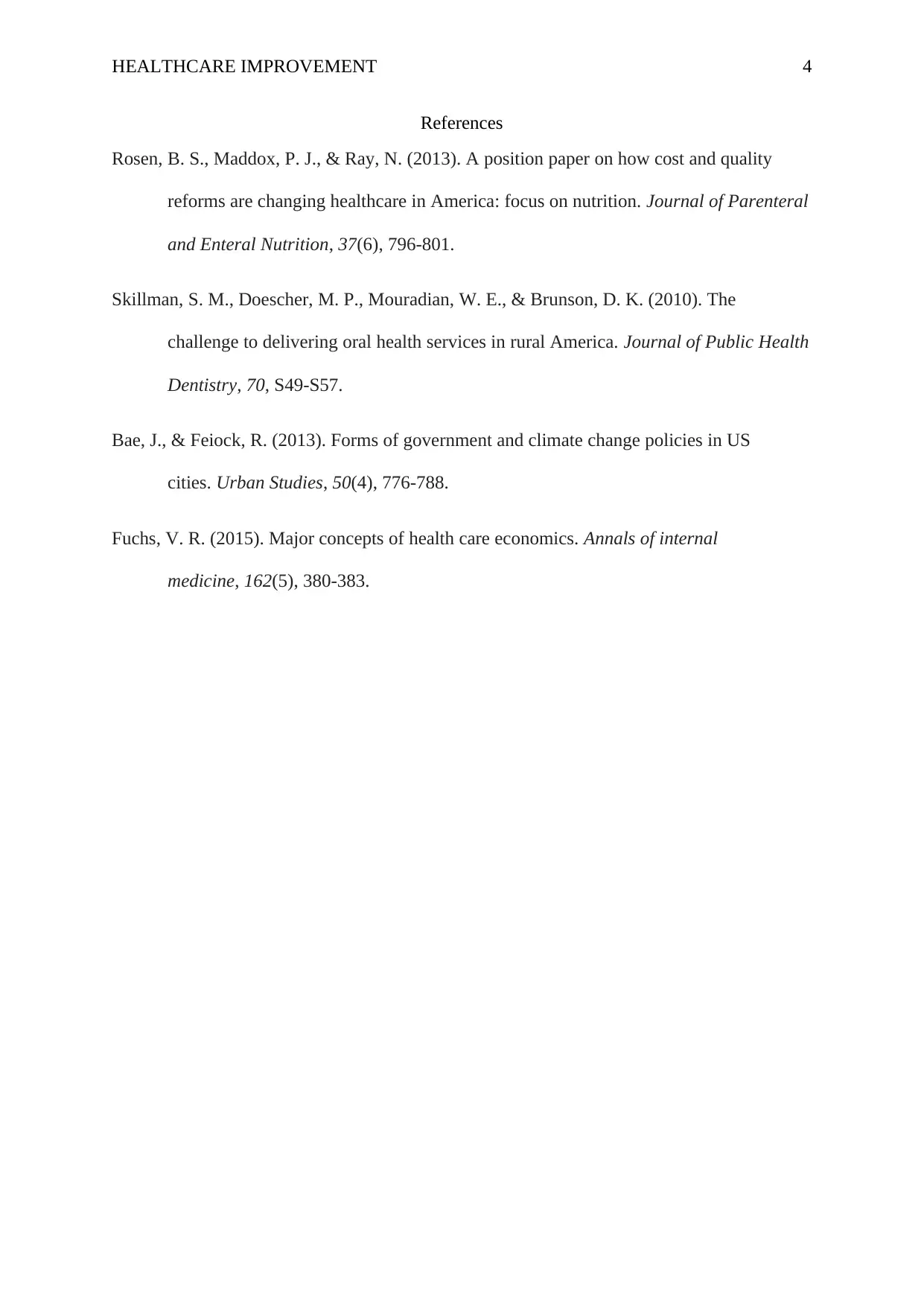Steps to Improve Healthcare Quality & Health Policy Dynamics
VerifiedAdded on 2023/04/07
|4
|689
|359
Discussion Board Post
AI Summary
This discussion post addresses healthcare quality improvement and health policy. It outlines steps to enhance healthcare quality, including hands-on projects, induction programs, balanced accountability, and human resource involvement. It also discusses methods for measuring current performance, such as collecting patient opinions and assessing communication. Furthermore, it identifies demanders (individuals, interest groups, organizations) and suppliers (executive, legislators, judiciary) in health policies, explaining their motivations within a political marketplace. The document emphasizes the importance of collaborative efforts between suppliers and demanders to ensure appropriate policies for healthcare operations. Desklib offers a platform to explore similar assignments and resources for students.

Running head: HEALTHCARE IMPROVEMENT 1
Healthcare Quality and Policy
Student’s Name
Institutional Affiliations
Date
Healthcare Quality and Policy
Student’s Name
Institutional Affiliations
Date
Paraphrase This Document
Need a fresh take? Get an instant paraphrase of this document with our AI Paraphraser

HEALTHCARE IMPROVEMENT 2
Steps to Improve and Measure Healthcare Quality
The quality of services delivered to patients determines the growth of the hospital and a
clinic. There has been a lot of complaints from the patients regarding the services provided to
them. Patient satisfaction is one of the essential factors that portrays the progress of a facility
(Rosen, Maddox & Ray, 2013). As a Quality Improvement Director, I need to come up with
principles that promote quality healthcare services. First, I will introduce a hands-on project.
This strategy focuses on expounding the positive impacts of quality services in a real-life
scenario. The application of this tool will also promote internal teams in the facility and
identify potential areas of weaknesses. The identified challenges will be managed promptly
since the program involves the participation of all stakeholders.
Secondly, I will introduce an induction program in the hospital. The quality
improvement team will help me in the training process. The induction sessions are meant to
train healthcare officers like nurses, clinical officers, social workers, laboratory technologists,
and doctors. Regular training is pivotal in ensuring that all staff performs their roles as
expected. Incorporation of a balanced accountability is another step taken to improve quality
in the healthcare sector. Accountability should be considerate but not emphasized within the
premises of the hospital because it may supersede the needs of the clients, therefore
increasing complaints (Skillman, Doescher, Mouradian & Brunson, 2010). In other words,
the management and all physicians should be held accountable for all activities carried out in
the facility. Lastly, the involvement of the Human resource department is another step to
improve the quality of services provided to patients. Human resource is important in
managing and overseeing the performance of the employees and making a report to the
overall management about the identified areas to improve.
Steps to Improve and Measure Healthcare Quality
The quality of services delivered to patients determines the growth of the hospital and a
clinic. There has been a lot of complaints from the patients regarding the services provided to
them. Patient satisfaction is one of the essential factors that portrays the progress of a facility
(Rosen, Maddox & Ray, 2013). As a Quality Improvement Director, I need to come up with
principles that promote quality healthcare services. First, I will introduce a hands-on project.
This strategy focuses on expounding the positive impacts of quality services in a real-life
scenario. The application of this tool will also promote internal teams in the facility and
identify potential areas of weaknesses. The identified challenges will be managed promptly
since the program involves the participation of all stakeholders.
Secondly, I will introduce an induction program in the hospital. The quality
improvement team will help me in the training process. The induction sessions are meant to
train healthcare officers like nurses, clinical officers, social workers, laboratory technologists,
and doctors. Regular training is pivotal in ensuring that all staff performs their roles as
expected. Incorporation of a balanced accountability is another step taken to improve quality
in the healthcare sector. Accountability should be considerate but not emphasized within the
premises of the hospital because it may supersede the needs of the clients, therefore
increasing complaints (Skillman, Doescher, Mouradian & Brunson, 2010). In other words,
the management and all physicians should be held accountable for all activities carried out in
the facility. Lastly, the involvement of the Human resource department is another step to
improve the quality of services provided to patients. Human resource is important in
managing and overseeing the performance of the employees and making a report to the
overall management about the identified areas to improve.

HEALTHCARE IMPROVEMENT 3
Effective quality improvement requires measurement of current performances in the
facility, therefore, quality is measured in different ways. First, collect patient opinions to
assess their experience in the hospital. This is because patient satisfaction is a direct
indication of improved healthcare. Assessment of the type of communication is another step
in determining the present quality (Bae, & Feiock, 2013). Communication between
employees and patient is a crucial factor in analyzing quality service delivery.
Health Policy
In a different dimension, healthcare is seen as a business because it consists of both
demanders and suppliers (Fuchs, 2015). Demanders are individual people, interest groups and
organizations. Health policy suppliers comprise; executive, legislators, and judiciary.
Demanders are motivated by their common goal. Individuals offer a great advantage in the
health policy because they are the main stakeholders. Interest groups are based on a non-
profit policy. They focus on representing the interests of the individuals and ensure that
public opinion is considered in the policy-making process. Organizations like medical
insurance companies and hospitals perform a critical roles to protect the interests of patients
during political activities. Suppliers in health policy have different roles, unlike the
demanders. Judiciary is motivated by its independence. Judicial members work without
political influence because their role is just to interpret the law (Fuchs, 2015). On the other
hand, legislators experience superiority as they determine the type of policies to be
implemented. In the political marketplace, the executive is motivated by the positive
outcomes of the implanted policies. Suppliers and demanders work jointly to ensure that the
policies are appropriate for the operation.
Effective quality improvement requires measurement of current performances in the
facility, therefore, quality is measured in different ways. First, collect patient opinions to
assess their experience in the hospital. This is because patient satisfaction is a direct
indication of improved healthcare. Assessment of the type of communication is another step
in determining the present quality (Bae, & Feiock, 2013). Communication between
employees and patient is a crucial factor in analyzing quality service delivery.
Health Policy
In a different dimension, healthcare is seen as a business because it consists of both
demanders and suppliers (Fuchs, 2015). Demanders are individual people, interest groups and
organizations. Health policy suppliers comprise; executive, legislators, and judiciary.
Demanders are motivated by their common goal. Individuals offer a great advantage in the
health policy because they are the main stakeholders. Interest groups are based on a non-
profit policy. They focus on representing the interests of the individuals and ensure that
public opinion is considered in the policy-making process. Organizations like medical
insurance companies and hospitals perform a critical roles to protect the interests of patients
during political activities. Suppliers in health policy have different roles, unlike the
demanders. Judiciary is motivated by its independence. Judicial members work without
political influence because their role is just to interpret the law (Fuchs, 2015). On the other
hand, legislators experience superiority as they determine the type of policies to be
implemented. In the political marketplace, the executive is motivated by the positive
outcomes of the implanted policies. Suppliers and demanders work jointly to ensure that the
policies are appropriate for the operation.
⊘ This is a preview!⊘
Do you want full access?
Subscribe today to unlock all pages.

Trusted by 1+ million students worldwide

HEALTHCARE IMPROVEMENT 4
References
Rosen, B. S., Maddox, P. J., & Ray, N. (2013). A position paper on how cost and quality
reforms are changing healthcare in America: focus on nutrition. Journal of Parenteral
and Enteral Nutrition, 37(6), 796-801.
Skillman, S. M., Doescher, M. P., Mouradian, W. E., & Brunson, D. K. (2010). The
challenge to delivering oral health services in rural America. Journal of Public Health
Dentistry, 70, S49-S57.
Bae, J., & Feiock, R. (2013). Forms of government and climate change policies in US
cities. Urban Studies, 50(4), 776-788.
Fuchs, V. R. (2015). Major concepts of health care economics. Annals of internal
medicine, 162(5), 380-383.
References
Rosen, B. S., Maddox, P. J., & Ray, N. (2013). A position paper on how cost and quality
reforms are changing healthcare in America: focus on nutrition. Journal of Parenteral
and Enteral Nutrition, 37(6), 796-801.
Skillman, S. M., Doescher, M. P., Mouradian, W. E., & Brunson, D. K. (2010). The
challenge to delivering oral health services in rural America. Journal of Public Health
Dentistry, 70, S49-S57.
Bae, J., & Feiock, R. (2013). Forms of government and climate change policies in US
cities. Urban Studies, 50(4), 776-788.
Fuchs, V. R. (2015). Major concepts of health care economics. Annals of internal
medicine, 162(5), 380-383.
1 out of 4
Related Documents
Your All-in-One AI-Powered Toolkit for Academic Success.
+13062052269
info@desklib.com
Available 24*7 on WhatsApp / Email
![[object Object]](/_next/static/media/star-bottom.7253800d.svg)
Unlock your academic potential
Copyright © 2020–2025 A2Z Services. All Rights Reserved. Developed and managed by ZUCOL.





